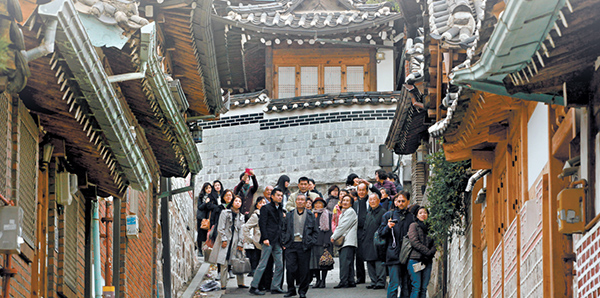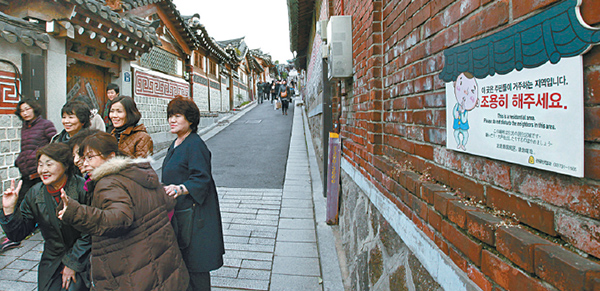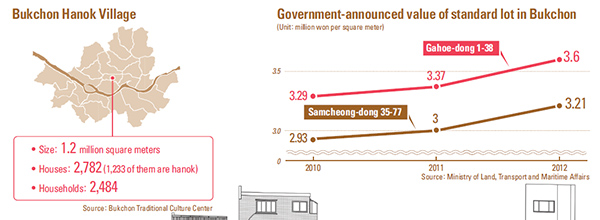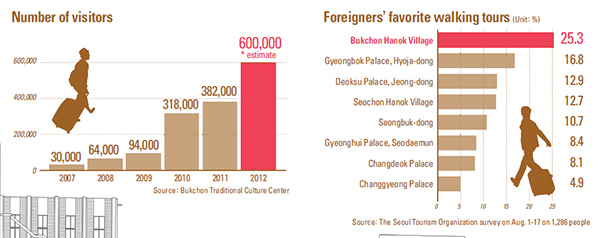Historic Bukchon besieged by tourists, businesses

On a recent Monday, rain and cold weather did little to stem the tide of tourists from flocking to Gahoe-dong street in the Bukchon Hanok Village, where residents are concerned about their quality of life. By Park Sang-moon
Teenage girls and boys were giggling, shrieking and running around.
A group of ajumma (middle-aged women) in comfortable outfits were taking group photos with their smartphones, making a peace sign with their fingers.
Japanese tourists got out of a white van parked in the alley and scrutinized each brick, door and window of the neighborhood.
The setting was Bukchon Hanok Village, one of most-beloved tourist sites in Seoul. The day’s weather was rough, with wind and rain, but that did not stop them from visiting and exploring between the Samcheong-dong area and the Changdeok Palace known for its beautiful cluster of hanok, or traditional Korean houses.
Such behavior is neither malicious nor unusual for tourists, but it can be annoying and disturbing - even rude - when it occurs outside the homes of people trying to take a nap, study for an exam or simply relax.
Bukchon Hanok Village refers to 11 administrative areas, like Gahoe-dong, Je-dong and Gye-dong, among others, and is home to 2,484 households, according to the data compiled by the Bukchon Traditional Culture Center, which operates under the Seoul Metropolitan Government.
As resident complaints mount, the Seoul government and Jongno District Office have been promoting what is called “silent tours” since April, installing signs among other initiatives to promote peace and quiet in the much visited neighborhood.
But on Monday, about seven months after the campaign started, silence didn’t seem to have taken hold.
Another issue with Bukchon Hanok Village is its rapid commercialization. Many experts in art, architecture and cultural properties express deep concern that the village could be the next Insa-dong, which many lament as lacking Korean culture and overrun by commercial establishments.

Signs that promote so-called silent tours are often overlooked by tourists. The city government says it plans to beef up the signs. By Park Sang-moon
Hallyu is the trigger
Not long ago, Bukchon was a quiet, low-profile neighborhood, where only a few tasteful, knowledgeable locals hung out.
In 2007, only 30,000 people visited the area, according to data from the Bukchon Traditional Culture Center.
However, in 2010 that number skyrocketed to 318,000. That was the year that Bukchon was featured in the popular “1 Night 2 Days” segment of “Happy Sunday,” a weekly entertainment show.
This year, the figure is expected to double to more than 600,000.
“ ‘1 Night 2 Days’ was the major trigger,” said Jung Mee-young of the Seoul City Wall Division of Seoul Metropolitan Government. Jung oversees operation of the Bukchon Traditional Cultural Center.
“Today, students come here on a school trip,” Jung says. “And we cannot control them. It’s not like there are opening hours or it’s registration only-based. They can come any day of the week, any time of the day.”
As a result, residents are living with tour buses and vans blocking traffic, tourists flocking to their alleys, talking loudly in all sorts of languages, taking photos of their houses and peeking at their doors.
Many locals find the tourist behavior an invasion of privacy and complain that their once peaceful lifestyle has been changed forever.
While “1 Night 2 Days” may have been the trigger for locals, the rising popularity of Hallyu appears to have been the catalyst for the rise in foreign tourists.
This is the opinion of Park In-sun, who has been living in a hanok in Bukchon for more than 20 years.
“Tourists have been rising steadily since ‘Winter Sonata’ [drama featuring Bae Yong-joon and Choi Ji-woo] became popular in Japan. First the Japanese tourists came, then the Southeast Asian tourists,” Park said.
“While I am very proud and thankful that my hometown is a globally beloved tourist site, it’s hard because you feel like you are living amid chaos. And during the weekend, it’s so bad that you even feel a sense of crisis.”
Park spent her childhood in the area because her grandmother lived in Samcheong-dong. She raised her children in Bukchon who are now attending high school and university. So leaving the neighborhood is something that she cannot imagine doing.
“My children were born here and they grew up here. And it’s not just us. Many families here have such a strong attachment to the area,” she said.
“So I guess now the fate of Bukchon is nothing but the coexistence of people’s residences with a cultural hot spot.”

Silence is golden
In April, Seoul Mayor Park Won-soon met with residents of the Bukchon Hanok Village and experts in art, architecture and cultural properties.
The Seoul Metropolitan Government is in the initial stages of the so-called “neighborhood community project” in which it promotes active exchanges and collaboration among neighbors and seeks growth and improvement of neighborhoods.
For the first two neighborhoods of the initiative, the government chose Bukchon and Seochon, which is west of Gyeongbok Palace and also features some old hanok.
The April meeting was a first step to collect ideas from the residents and experts.
In the meeting, the idea of the silent tour was hatched.
It was brought up by Kim Hong-nam, a Bukchon resident and respected art historian. She is a professor at the Graduate School of Ewha Womans University as well as head of the National Trust of Korea.
In the past, she was director of the National Museum of Korea and National Folk Museum of Korea.
“Silent tours are promoted in Kyoto, where there are many areas that are both residential areas and tourist sites,” said Kim.
“Many hanok in Bukchon are quite small, measuring between 25 and 30 pyong [893 and 1,065 square feet]. And because of the small lots, some houses are built in a way so that their fence is practically the wall of their house, making it very vulnerable to outside noise.”
According to architecture experts, hanok are particularly vulnerable to outside noise because they were traditionally built of wood and paper. That is why some say, only half joking, that you can even hear people farting outside.
Since the meeting, the Bukchon Traditional Culture Center has promoted silent tours through a pop-up in its Web site and has installed 14 signs in the alleys.
It also required helpers to wear silent tour chest bands, though they have not been worn since August. The center also said it has published new maps with phrases encouraging silence, but those maps are yet to be distributed.
After seven months of such a limited campaign, the results should not be surprising.
“Silent tour? I haven’t heard anything about it,” said Han Seong-suk, a middle-aged woman who came to Bukchon with three friends. “Oops, I guess I should’ve been quieter.” Han and her friends had just finished exploring the area.
Amol Mittal, a tourist from California, also said he saw the sign only on his way out of the main Gahoe-dong street of Bukchon. “I’ve seen places like this in Korean movies. It’s gorgeous how they preserved all these old-style housings,” he said. “But I can sympathize with the residents, how they would want some silence. But I think they need to put more signs in more places.”

Tighter regulation is key
One could argue that if you don’t like the noise, move to somewhere quieter.
Many residents of the capital have month-to-month or yearly leases, so moving from one neighborhood to another may seem like a normal part of life. In fact, with the recent popularity of the Samcheong-dong area, where there are about 3,500 trendy and chic cafes, restaurants, galleries and shops, and Bukchon Hanok Village, property prices have skyrocketed. So selling the properties in this area could yield big profits. For some Bukchon residents, however, it’s not all about money.
Demographics in Bukchon, Seoul government officials say, are either those who have lived there for a long time, like Park In-sun, or those who moved in recently looking for a quieter, more peaceful lifestyles.
Kim Hong-nam spent two years to build her hanok here and moved in 2010. Many Bukchon residents are committed to preserving the traditional hanok, which represents Korean identity. Many of the traditional structures were demolished in Korea’s industrialization phrase.
“What’s more worrisome than the influx of tourists is commercialization,” said Kim.
“The central government and district office have designated areas where there can only be residences and where there can also be commercial entities. But people don’t always abide by the rules. For instance, they first install a deck. Then they start selling food. Not long after, the place is commercialized and filled with litter.”
However, others point out that it depends on which part of the Bukchon they live in.
Robert Fouser, a longtime expat in Korea and an associate professor of Korean language education at Seoul National University, said, “Samcheong-dong and Gahoe-dong areas are where there are relatively bigger hanok and thus more noisy with tourists.”
Fouser lives in Gye-dong, which he describes as “less crowded and less loud.”
Meanwhile, observers worry that even with the economic recession, the Samcheong-dong area is seeing no decrease in the number of tourists.
The planned opening of the National Museum of Contemporary Art in March in Samcheong-dong will only add to the crowds.
The concerns of the residents, in the meantime, continue and deepen.
“Bukchon is what it is today because of people living here. It’s not an artificially created village like the folk villages,” said Kim Hong-nam.
“But once it gets more crowded and commercialized, residents will leave. Then, it won’t be the Bukchon we know anymore.”
By Kim Hyung-eun [hkim@joongang.co.kr]










with the Korea JoongAng Daily
To write comments, please log in to one of the accounts.
Standards Board Policy (0/250자)